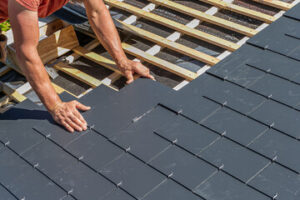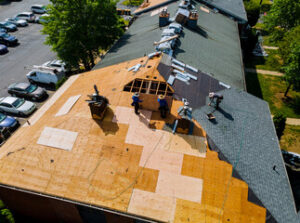If your roof is showing signs of wear, re-roofing may be an option. It’s usually much cheaper than a full replacement.

The type of materials used can affect the cost. There are a number of options, from traditional shingles to metal roofs.
Before the roofing crew starts work, you’ll need to move things like outdoor furniture and ceramic landscaping features. You should also trim back any trees encroaching on the roof and clear the area of debris.
A new roof is one of the most expensive home renovation projects. The average roof replacement costs between $9,117 and $12,498. The cost of a new roof depends on the material, square footage and location. However, the main factor that drives the final cost of a new roof is labor. In general, the roof replacement cost includes tearing off the old roof and installing the new one. It also includes repairing any damage to the underlying roof structure. It may also include new flashing, roof ridges and vents. Depending on the type of roofing material, the cost can increase or decrease significantly.
The cost of a new roof depends on several factors, including the type of roofing material and its durability. It also depends on the size and shape of the roof, as well as whether there are any features like chimneys or skylights. Another factor is the roof pitch, which is the degree of slope of your roof. Steeper roofs are more difficult to work on and require specialized equipment, which can increase the cost of the job.
Depending on the type of roof, the total cost can vary from $8,500 to $11,000. In general, the cost of a new roof is 40 percent materials and 60 percent labor. Materials include shingles, shakes, tiles or slate. Labor expenses account for about $3 per square foot, but can be higher on steep or complex jobs.
Homeowners insurance typically covers the cost of a new roof, provided the damage is not caused by neglect or intentional damage. However, the type of coverage varies by policy. Some policies do not cover the cost of repairs, while others cover only the actual value of the roof.
A new roof is an expensive project, so it is important to evaluate all the pros and cons of repair or replacement before making a decision. In some cases, a repair may be more cost-effective than replacing the entire roof. Other options include a personal loan, which has higher interest rates than a mortgage or HELOC, but is less risky than putting your house on the line.
Warranty
If you’re shopping around for a roof replacement, one of the first things you should look for is the warranty offered by the company. Your roofing system is your home’s first line of defense against all that nature throws at it 24/7/365, and the investment you make deserves the protection offered by manufacturer and workmanship warranties.
Most roof installation and replacement projects are covered, at least partially, by manufacturer warranties for products or materials. These are usually available through the roofer or on their website, and cover the typical lifespan of a particular roofing material. For instance, architectural shingles may be guaranteed for longer than three-tab shingles.
Some manufacturers also offer a “Total System Warranty.” This type of warranty typically requires that all the components of a roofing system be purchased from the same manufacturer, including flashings and insulation. This type of warranty is sometimes available for an additional cost, but it provides the most comprehensive coverage.
Most contractors will also offer a workmanship warranty for their work. This is a guarantee that the contractor will address any problems that occur during the installation process. The length of the warranty will vary, but it is always a good idea to choose a roofer that offers this kind of protection.
While most homeowners are aware that manufacturer and workmanship warranties are available, they may not be fully aware of what the specifics of each are. For example, there are a variety of different warranty terms and conditions for each, as well as the potential for transfer when a property changes ownership. It’s important to communicate with a roofing contractor about the details of each warranty and to understand how they interact.
It’s also worth noting that many warranties will be voided if the homeowner attempts to perform repairs themselves. This is why it’s so important to work with a professional roofing specialist instead of a jack-of-all-trades general contractor. It’s much like going to a doctor for an issue that requires specialized knowledge, rather than going to your local hardware store for the solution.
Appearance
A roof replacement can improve the overall appearance of your home. A new section will blend in with the older part of the roof and hide any areas that are visibly damaged or deteriorating. Look for any stains that may indicate leaks — these are particularly noticeable in the attic or anywhere near gutters or low points on the roof. Also check the flashing around vents, skylights and chimneys to make sure it’s intact and sealing properly.
Maintenance
Roof maintenance is a crucial part of preserving your home’s value and extending its life span. It helps spot problems before they deteriorate to the point of requiring costly repairs or even complete replacement. During maintenance visits, trained roofers examine the surface material for signs of damage, such as missing or cracked shingles, sagging or weakened spots on the structure and exposed or loose nails. In addition, they look for pest infestations (rats, squirrels, raccoons and bees) and check for proper ventilation to prevent heat damage.
If your roof is showing obvious damage, such as a sagging roof, it may be time to replace it. A professional roofer can help you decide whether to repair the existing damaged materials or replace the entire roof. The decision is usually based on the extent of the damage and the age of the roof. Repairs can be a good option for newer roofs with minor damage, but it might be more practical to invest in a full replacement for an older roof that has extensive, widespread damage that can’t be repaired.
During a roof replacement, the roofing crew will remove the old roofing material, including shingles, tiles or shakes. Then, they’ll install the new roof. The crew might also replace the fascia boards, which are the long wooden boards that protect the lower edges of the roof. These can be susceptible to rot, mold growth, insect infestations and water damage.
Other roof maintenance tasks include inspecting areas where different roof planes meet, such as in valleys. This is a common place for leaks. They should be caulked and resealed as needed. Inspecting gutters and downspouts is also important, as they’re often the first line of defense against water infiltration.
It’s a good idea to cover outdoor items like hoses, toys and birdhouses with tarps during the roof replacement process. This will shield the items from debris and dust that might fall during the work, and it will also keep them safe until the roofing contractor can return them to their original location. Similarly, it’s a good idea to move vehicles from the work area during a roof replacement to avoid blocking driveways or parking spaces. This will facilitate smooth progress of the project.
